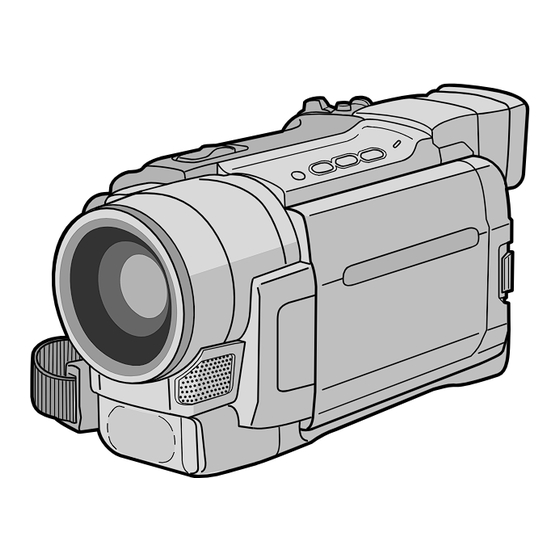Table of Contents
Advertisement
JVC SERVICE & ENGINEERING COMPANY OF AMERICA
DIVISION OF JVC AMERICAS CORP.
Head office
:
1700 Valley Road Wayne, New Jersey 07470-9976
:
10 New Maple Avenue Pine Brook, New Jersey 07058-9641
East Coast
:
705 Enterprise Street Aurora, Illinois 60504-8149
Midwest
:
5665 Corporate Avenue Cypress, California 90630-0024
West Coast
:
1500 Lakes Parkway Lawrenceville, Georgia 30043-5857
Atlanta
:
2969 Mapunapuna Place Honolulu, Hawaii 96819-2040
Hawaii
JVC CANADA INC.
Head office
:
21 Finchdene Square Scarborough, Ontario M1X 1A7
:
Montreal
16800 Rte Trans-Canadienne, Kirkland, Quebec H9H 5G7
:
Vancouver
13040 Worster Court Richmond, B.C. V6V 2B3
(973)317-5000
(973)396-1000
(630)851-7855
(714)229-8011
(770)339-2582
(808)833-5828
(416)293-1311
(514)871-1311
(604)270-1311
S40895-04
Printed in Japan
SERVICE MANUAL
DIGITAL VIDEO CAMERA
GR-DVL220U,DVL320U,DVL520U,
DVL522U,DVL720U
SPECIFICATIONS
(The specifications shown pertain specifically to the model GR-DVL320/DVL520/DVL720)
Camcorder
General
Power supply
: DC 11.0 V } (Using AC Adapter)
DC 7.2 V } (Using battery pack)
Power consumption
LCD monitor off, viewfinder on : Approx. 4.3 W
LCD monitor on, viewfinder off : Approx. 5.3 W
Video light
: Approx. 3.5 W
Dimensions (W x H x D) : 79 mm x 89 mm x 167 mm (3-1/8" x 3-9/16" x 6-5/8")
(with the LCD monitor closed and the viewfinder
pushed down)
Weight
: Approx. 570 g (1.3 lbs) (GR-DVL720)
Approx. 560 g (1.3 lbs) (GR-DVL520)
Approx. 550 g (1.3 lbs) (GR-DVL320)
Operating temperature : 0°C to 40°C (32°F to 104°F)
Operating humidity
: 35% to 80%
Storage temperature
: –20°C to 50°C (–4°F to 122°F)
Pickup
: 1/4" CCD
Lens
: F 1.8, f = 3.8 mm to 38 mm, 10:1 power zoom lens
Filter diameter
: ø37 mm
LCD monitor
: 3.5" diagonally measured, LCD panel/TFT active
matrix system (GR-DVL720)
2.5" diagonally measured, LCD panel/TFT active
matrix system (GR-DVL520/DVL320)
Viewfinder
: Electronic viewfinder with 0.24" black/white LCD
Speaker
: Monaural
Digital Video Camera
Format
: DV format (SD mode)
Signal format
: NTSC standard
Recording/Playback format : Video: Digital component recording
: Audio: PCM digital recording, 32 kHz 4-channel (12-bit),
48 kHz 2-channel (16-bit)
Cassette
: Mini DV cassette
Tape speed
: SP: 18.8 mm/s
LP: 12.5 mm/s
Maximum recording time : SP: 80 min.
(using 80 min. cassette) LP: 120 min.
This service manual is printed on 100% recycled paper.
COPYRIGHT © 2001 VICTOR COMPANY OF JAPAN, LTD.
Digital Still Camera Function (GR-DVL720/DVL520 only)
Storage media
: SD Memory Card/MultiMediaCard
Compression system : JPEG (compatible)
File size
: 2 modes (1024 x 768 pixels, 640 x 480 pixels)
Picture quality
: 2 modes (FINE/STANDARD)
Approximate number of storable images
with memory card [8 MB] (provided)
FINE
: 20 (1024 x 768 pixels), 45 (640 x 480 pixels)
STANDARD
: 65 (1024 x 768 pixels), 160 (640 x 480 pixels)
For other memory cards, «g. 27.
Connectors
S-Video
Output
: Y:1 V (p-p), 75 , analog
C:0.29 V (p-p), 75 , analog
AV
Video output
: 1 V (p-p), 75 , analog
Audio output
: 300 mV (rms), 1 k, analog, stereo
DV
Output
: 4-pin, IEEE 1394 compliant
Input
: 4-pin, IEEE 1394 compliant
USB (GR-DVL720/DVL520 only) : 5-pin
PC (GR-DVL320 only)
:
ø2.5 mm, 3-pole
EDIT (GR-DVL720/DVL520 only) : ø3.5 mm, 2-pole
JLIP (GR-DVL320 only)
: ø3.5 mm, 4-pole
AC Adapter
Power requirement
U.S.A. and Canada : AC 120 V `, 60 Hz
Other countries
: AC 110 V to 240 V `, 50 Hz/60 Hz
Output
: DC 11 V } , 1 A
Specifications shown are for SP mode unless otherwise indicated. E & O.E.
Design and specifications subject to change without notice.
No. 86658
December 2001
Advertisement
Table of Contents














Need help?
Do you have a question about the GR-DVL220U and is the answer not in the manual?
Questions and answers